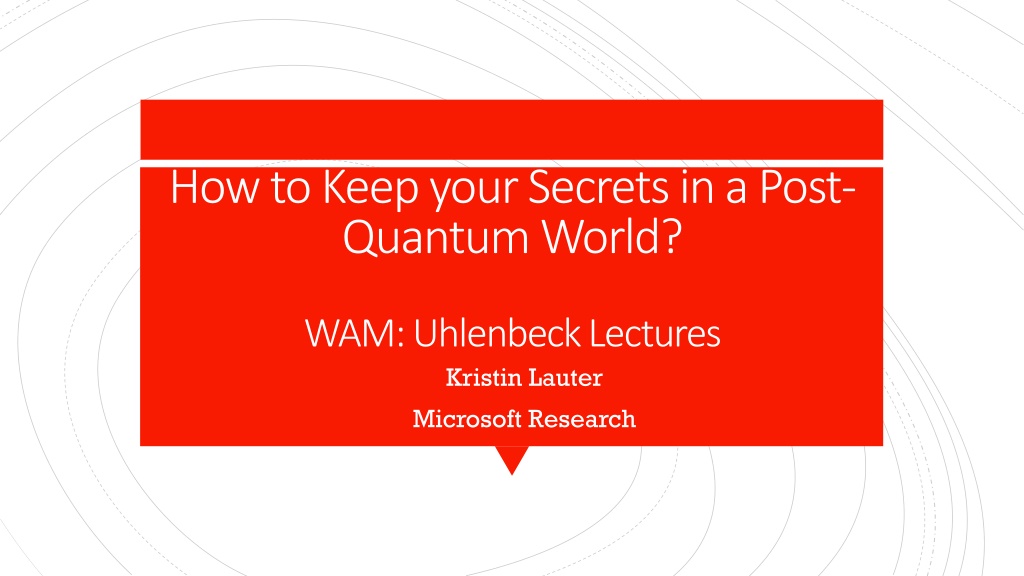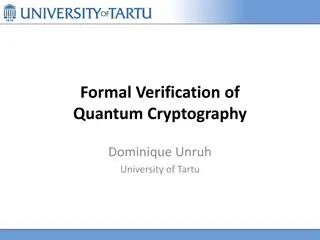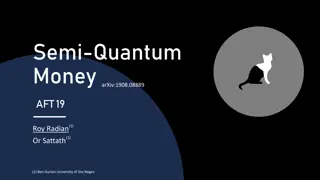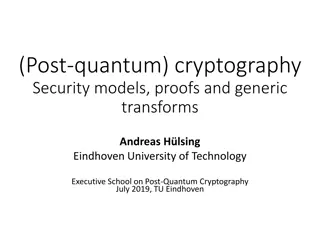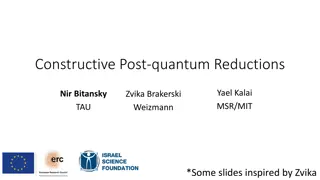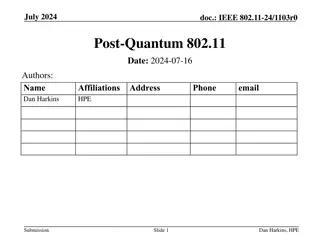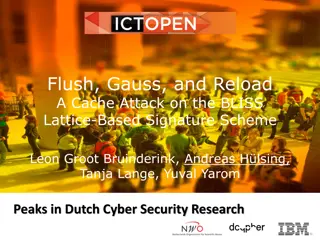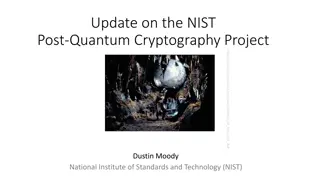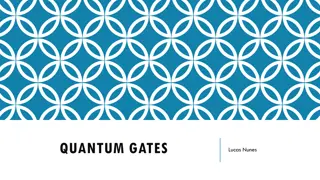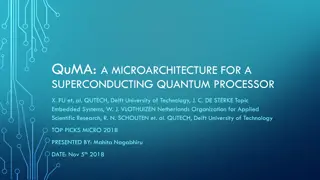Post-Quantum Cryptography: Safeguarding Secrets in the Digital Age
Delve into the realm of post-quantum cryptography and learn about the evolving landscape of secure communication. Explore topics such as Supersingular Isogeny Graphs, Ring-Learning With Errors, and the significance of key exchange in maintaining confidentiality. Discover the foundations of public key cryptography and its applications in securing data, communication, and digital identities. Uncover the timeline of cryptographic advancements from classical to quantum eras, culminating in the introduction of Shor's quantum algorithm for factoring. Join us on a journey through the science of secrecy and its vital role in modern cybersecurity.
- Post-Quantum Cryptography
- Cybersecurity
- Public Key Cryptography
- Secure Communication
- Quantum Computing
Download Presentation

Please find below an Image/Link to download the presentation.
The content on the website is provided AS IS for your information and personal use only. It may not be sold, licensed, or shared on other websites without obtaining consent from the author. Download presentation by click this link. If you encounter any issues during the download, it is possible that the publisher has removed the file from their server.
E N D
Presentation Transcript
How to Keep your Secrets in a Post- Quantum World? WAM: UhlenbeckLectures Kristin Lauter Microsoft Research
Goal: Convey context and status of Post-Quantum Cryptography (PQC) What is PQC? Current Proposals for PQC Familiarity with algorithms and running times Introduce Supersingular Isogeny Graphs (SIG) Introduce Ring-Learning With Errors (RLWE) Course Goals
Day 1: Supersingular Isogeny Graphsdefinitions and applications Day 2: Hard Problems number theory attacks Course Outline Day 3: RLWE motivation and definition of schemes Day 4: Attacks on Ring-LWE for special rings.
The science of keeping secrets! But more than that Confidentiality Authenticity Cryptography: Tools: Encryption/Decryption Digital signatures Key exchange
Key exchange: two parties agree on a common secret using only publicly exchanged information Signature schemes: allows parties to authenticate themselves Public Key Cryptography Encryption: preserve confidentiality of data Examples of public key cryptosystems: RSA, Diffie-Hellman, ECDH, DSA, ECDSA 5
Each party has a *publicly available* key Public key encryption Publicly verifiable signatures Public Key Exchange Security of systems in based on some hard math problem: Public Key Cryptography: Factoring large integers (RSA) Discrete logarithm problem in (Z/pZ)* (DLP) Elliptic curve groups (ECC): Discrete logarithm problem (ECDLP) Weil pairing on elliptic curves
Secure browser sessions (https: SSL/TLS) Signed, encrypted email (S/MIME) Applications: Virtual private networking (IPSec) Authentication (X.509 certificates) 7
1980-82-85: Idea introduced by Benioff, Manin, Feynman, Deutsch 1994 Shor's poly time quantum algorithm for factoring Quantum Computers! 2001 factorization of 15 using a 7-qubit NMR computer. 2011 researchers factored 143 using 4 qubits 2016: Station Q, Microsoft Research, Quantum Compiler, LiQuiD
Basic arithmetic is different Requires quantum circuits consisting of quantum gates Quantum Arithmetic Quantum logic gates are represented by unitary matrices Dependent on architecture design
m = # bits Shor s algorithm for factoring 4m3 time and 2m qbits ECC attack requires 360m3 time and 6m qbits (Proos-Zalka, 2004) Polynomial time Quantum algorithms Conclusion: RSA: m = 2048 Discrete log m = 2048 Elliptic Curve Cryptography m = 256 or 384 Are not resistant to quantum attacks once a quantum computer exists at scale!
(2006) Suite B set requirements for the use of Elliptic Curve Cryptography (2016) CNSA requirements increase the minimum bit-length for ECC from 256 to 384. Advises that adoption of ECC not required. Timeline for ECC (2017) NIST international competition to select post-quantum solutions: PQC Competition
Code-based cryptography (McEliece 1978) Multivariate cryptographic systems (Matsumoto-Imai,1988) Hash-based cryptosystems (Merkle, 1989) Post-quantum cryptography Lattice-based cryptography (Hoffstein-Pipher-Silverman, NTRU 1996) Supersingular Isogeny Graphs (Charles-Goren-Lauter 2006) Challenge! Need to see if these new systems are resistant to *both* classical and quantum algorithms!
New hard problem introduced in 2006: [Charles-Goren-Lauter] Finding paths between nodes in a Supersingular Isogeny Graph Supersingular Isogeny Graphs Graphs: G = (V, E) = (vertices, edges) k-regular, undirected graphs, with optimal expansion No known efficient routing algorithm
A hash function maps bit strings of some finite length to bit strings of some fixed finite length h : {0,1}n {0,1}m easy to compute unkeyed (do not require a secret key to compute output) Collision resistant Uniformly distributed output Hash functions
Security of most cryptographic protocols Password verification Integrity check of received content Cryptographic Hash functions: Practical applications Signed hashes Encryption protocols Message digest Microsoft source code (720 uses of MD5)
A hash function h is collision resistant if it is computationally infeasible to find two distinct inputs, x, y, which hash to the same output h(x) = h(y). Collision- resistance A hash function h is preimage resistant if, given any output of h, it is computationally infeasible to find an input, x, which hashes to that output.
k-regular graph G Each vertex in the graph has a label Application: cryptographic hash function [CGL 06] Input: a bit string Bit string is divided into blocks Each block used to determine which edge to follow for the next step in the graph No backtracking allowed! Output: label of the final vertex of the walk
Random walks on expander graphs are a good source of pseudo-randomness Are there graphs such that finding collisions is hard? (i.e. finding distinct paths between vertices is hard) Simple idea Bad idea: hypercube (routing is easy, can be read off from the labels)
Random walks on expander graphs mix rapidly: ~log(p) steps to a random vertex, p ~ #vertices Ramanujan graphs are optimal expanders What kind of graph to use? To find a collision: find two distinct walks of the same length which end at same vertex
Walk on a graph: 110 1 1 0 1 0 0 0 1 1 0
Colliding walks: 1100 and 1011 1 1 0 1 0 0 0 1 1 0 0 1
Vertices: supersingular elliptic curves mod p Curves are defined over GF(p2) (or GF(p)) Graph of supersingular elliptic curves modulo p with isogeny edges (Pizer graphs) Labeled by j-invariants E1 : y2 = x3 + ax + b j(E1)= 1728*4a3/(4a3+27b2) Edges: Isogenies between elliptic curves
Elliptic curve Supersingular Isogeny J-invariant Lots of deep and beautiful theorems in number theory describe the properties of these graphs Need to define: Supersingular is key: Graph is Ramanujan (Eichler, Shimura) Size, regularity of the graph Undirected if we assume p == 1 mod 12
Vertices: supersingular elliptic curves mod p # vertices ~ p/12 p ~ 2256 Curves are defined over GF(p2) Labeled by j-invariants Graph of supersingular elliptic curves modulo p (Pizer) Edges: degree isogenies between them k = +1 regular
The degree of a separable isogeny is the size of its kernel To construct an -isogeny from an elliptic curve E to another, take a subgroup-scheme C of size , and take the quotient E/C. Isogenies Formula for the isogeny and equation for E/C were given by Velu.
E1 : y2 = x3 +ax+b j(E1)=1728*4a3/(a3+27b2) 2-torsion point Q = (r, 0) One step of the walk: ( =2) E2 = E1 /Q (quotient of groups) E2 : y2 = x3 (4a + 15r2)x + (8b 14r3). E1 E2 (x, y) (x +(3r2 + a)/(x-r), y (3r2 + a)y/(x-r)2)
Science magazine 2008
Charles-Goren-Lauter presented at NIST 2005 competition, IACR eprint 2006, published J Crypto 2009 Later in 2006, two papers on eprint, never published: Couveignes, ordinary case (Hard Homogeneous Spaces) Rostovtsev-Stolbunov, ordinary case (Encryption) History Ordinary case is very different for many reasons: Volcanoe structure of graph Action of an abelian class group Known subexponential classical algorithms to attack
Security based on hardness of factoring n=p*q (n) = (p) (q) = (p 1)(q 1) = n - (p + q -1) Choose an integer e such that gcd(e, (n)) = 1 Determine d as d e 1(mod (n)); Public key (n, e) Private key (n,d) RSA p, q, and (n) secret (because they can be used to calculate d) Encryption cryptosystems (~1975) Decryption
32 Given a cyclic group G generated by g Alice picks random a Bob picks random b Diffie-Hellman Key Exchange Alice sends ga Bob sends gb Secret : g ab = (g b) a = (g a) b
33 Elliptic Curve Cryptography (ECC) is an alternative to RSA and Diffie-Hellman, primarily signatures and key exchange Proposed in 1985 (vs. 1975 for RSA) by Koblitz and Miller Security is based on a hard mathematical problem different than factoring ECDLP Elliptic Curve Cryptography ECC 25th anniversary conference October 2010 hosted at MSR Redmond Pairing-based cryptography currently entirely on pairings on elliptic curves
Group of points (x, y) on an elliptic curve, y 2 = x 3 + a x + b, Over a field of minimum size: 256-bits Elliptic CURVE Groups (short Weierstrass form, characteristic not 2 or 3) Identity in the group is the point at infinity Group law computed via chord and tangent method
35 Group Law on an Elliptic Curve R1 Q2 Q1 R1 Q1 + Q2= R1
Genus 2 Jacobians ?2= ?5+ ?4?4+ ?3?3+ ?2?2+ ?1? + ?0 ?2= ?3+ ?2?2+ ?1? + ?0 How to add pairs of points? #Jac??? ?2 #? ?? ?
Security based on hardness of factoring n=p*q p and q have equal size Otherwise: Elliptic curve factoring method finds factors in time proportional to the size of the factor (H. Lenstra, `85) Quadratic Sieve (Fermat, Kraitchik, Lehmer-Powers, Pomerance) Number field sieve (NFS) runs in subexponential time RSA Security O(ec (log n)^1/3 (log log n)^2/3) c=1.526 Special NFS; c=1.92 General NFS Pollard `88, Lenstra-Lenstra-Manasse `90, Coppersmith `93,
Square-root algorithms: Baby-Step-Giant-Step (Shanks `71) Pollard rho (Pollard, `78) Pohlig-Hellman, `78 Discrete logarithm problem in (Z/pZ)* Subexponential: Index calculus (Adleman, `79) Recent significant breakthroughs, improving the exponent in subexponential algorithms for DLP to for small characteristic: Function Field Sieve (Joux 2013)
MenezesOkamotoVanstone (MOV) attack `93: supersingular elliptic curves Semaev, Satoh, Smart `98-`99 (Trace 1) Elliptic Curve Cryptography Generic square-root algorithms: Baby-Step Giant-Step, Pollard's rho No generic, classical sub-exponential algorithm known
